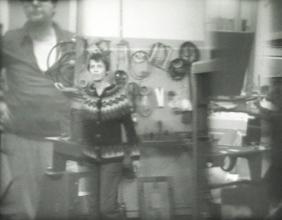Vašulka Mediascape
Steina, Orbital Obsessions (1977, 24:30)/includes Switch! Monitor! Drift! (1976), see especially 13:00-18:30)
“Switch! Monitor! Drift! is one of a series of “machine visions” constructed by Steina in the ’70s. In this documentation of a studio landscape, two cameras’ signals are combined through a luminance keyer. One camera is mounted on a turntable; the second camera is pointed at the first. The image from the stationary camera is time-base adjusted [using George Brown’s Variable Clock] so that it appears to drift horizontally across the monitor, exposing the horizontal framing interval, a black (low voltage) area that is normally hidden from view. The signal of the revolving camera is keyed into this area. The revolving second camera continuously pans the studio, occasionally revealing Steina walking around and flipping a directional switch at the turntable. As the tape progresses the luminance key is adjusted to include a broader tonal range through which the signal from the revolving camera is increasingly visible.”
Chris Hill, “Program 5,” Rewind, guide for Surveying the First Decade collection, Chris Hill, curator, Video Data Bank, Chicago (1996); link: https://www.vdb.org/sites/default/files/2020-04/Rewind_VDB_July2009%202.pdf.
Steina: “It was a challenge to me to create a space that would not deal with the idiosyncrasy of human vision.”
Robert Haller, “An Interview with Steina,” (1981) in Buffalo Heads, Woody Vašulka & Peter Weibel, eds, ZKM, Karlsruhe (2008); link: https://www.vasulka.org/archive/RightsIntrvwInstitMediaPolicies/IntrvwInstitKaldron/8/HallerSteina.pdf.
“Orbital Obsessions includes excerpts from Signifying Nothing (1975), Sound and Fury (1975), Switch! Monitor! Drift! (1976) and Snowed Tapes (1977). In these pieces, Steina focuses on time, space, and movement, and the means by which the mechanical can inform and engage with electronic media….”
EAI catalog https://www.eai.org/titles/orbital-obsessions.
